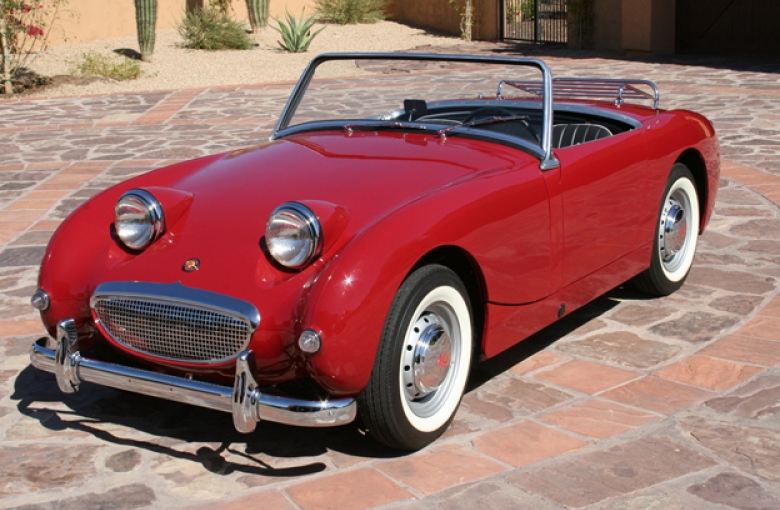Collectable British Vintage Cars

1958 Austin Healey Sprite
Collecting automobiles is an expensive hobby. Not only is there the cost of buying your favourite cars, there are also upkeep costs, potential issues with finding replacement parts, finding space to store them, deciding how often to give in to the temptation of driving your beauties, and of course… insurance.
When it comes to collectable cars, British cars seem to be high on the list. Looking at online ‘Top 10’ lists, you will usually find that there are more British cars included than any other. The British have certainly contributed a fine collection of excellent automobiles.
With all that said, here are five particularly cool vintage British cars.
1958 Austin-Healey Sprite Mark 1
In May of 1958, the Sprite was introduced in Monte Carlo. The Sprite was presented as an inexpensive, fun sports car. It came equipped with a mildly modified Austin A-Series motor and several other parts scavenged from established cars in order to reduce costs.
The Sprite’s distinctive headlight placement was another cost cutting move and led to the affectionate nicknames Frogeye in Britain and Bugeye in America.
1958 Austin-Healey Sprite Mark 1
Years Produced 1958-1961
Body style 2-seat roadster
Number built 48,987
Wheelbase 80”
Engine 0.9L A-Series I4
Maximum horsepower 43
1956 Rolls Royce Silver Cloud I
All over the world, Rolls Royce is known as the epitome of luxury and grace in automobile design. From 1955 to 1966, the Silver Cloud was the flagship example of iconic Rolls-Royce motor cars.
The car offered a 155 hp 4.9 L 6-cylinder engine with overhead exhaust and automatic transmission as standard. You could also have power steering and air conditioning, but at a top speed of 102 mph, you might not need it.
1956 Rolls Royce Silver Cloud I
Years Produced 1955-1958
Body style 4-door saloon (sedan)
Number built 7372
Wheelbase 123“
Engine 4.9L I6
1958 MGA Twin Cam
The Twin Cam was an attempt to offer an MGA that was more powerful. In 1958, the special “1600 Twin Cam” was introduced. The engine boasted hemispherical combustion chambers and a 9.9:1 compression ratio. This brought the engine up to an impressive 108 hp and a top speed that could reach more than 110 mph.
The Twin Cam added a whopping $850 ($6839 in 2013 dollars) surcharge to the cost of the car. It also turned out to have a knocking problem when using regular fuel. This led to the car being identified as a heavy oil user and sales ultimately suffered as a result. In 1960, MG stopped production of this nevertheless gorgeous car after manufacturing only 2111 units.
1958 MGA Twin Cam
Years Produced 1958-1960
Body style 2-seat roadster
Number built 2111
Wheelbase 94“
Engine Twin cam four-cylinder
Maximum horsepower 108
1954 Jaguar D-Type
The 1954 Jaguar D-Type makes the list for being one of the most sought after collectable cars. The D-Type was created for racing and it arrived with the groundbreaking innovation of a monocoque chassis which brought with it an important step forward in the application of aerodynamic principles for racing cars.
When Jaguar pulled out of racing, changes to the racers such as an extra door and seat, a full-width windshield and folding top were made to make the cars more consumer friendly.
On February 12, 1957, a fire at the factory destroyed nine out of the estimated 71 vehicles that were in various stages of conversion.
1954 Jaguar D-Type Specifications
Years produced 1954-1956
Body style Roadster
Number built 71
Wheelbase 90”
Engine XK-6, aluminum head with two overhead cams, two valves per cylinder, I-6, iron block
Maximum horsepower 265
In 1947, Aston Martin had designed a new model dubbed the “Atom,” but the company had no funds to get the car into production. Industrialist David Brown bought the company, and the updated Atom was renamed the DB1 (David Brown first model). The vehicle offered a tube frame chassis with a 2.0-liter, 4-cylinder engine and overhead valves.
The prototype was entered into the Belgian Spa 24-Hour race and the car won the race outright. However, in production the car was heavy and expensive to build, and only 15 were ever made. A unique feature of the DB1 was the spare wheel compartment in a front wing.
1948 Aston Martin DB1 Specifications
Years produced 1948-1950
Body style 2-seat roadster
Number built 15
Wheelbase 108“
Engine 1.97 liter I4
Maximum horsepower 90
